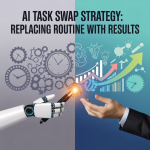
Growth Hacking
Growth hacking is like being MacGyver in the business world – you’re armed with duct tape, a paperclip, and sheer creativity, trying to rig together explosive growth before anyone realizes you didn’t have a proper budget.
Growth Hacking: Before AI
Ah, the pre-AI days of growth hacking, when the term “hacking” was less about sophisticated strategies and more about throwing spaghetti at the wall to see what stuck.
Back then, growth hacking felt like trying to build an IKEA dresser without the manual and realizing halfway through that you’re missing a screw.
First, there was the brainstorming phase.
You’d gather your scrappy team of dreamers, doers, and over-caffeinated interns in a tiny room with a whiteboard and ask, “Okay, how do we grow fast?”
The ideas would start flying: “What if we make a viral TikTok? Or host a flash mob in Times Square? Or send free samples to every influencer on Instagram?”
Every idea sounded brilliant at first, until someone asked, “But… how do we afford this?” Cue the awkward silence.
Then came the execution phase, where you’d try every trick in the book to get noticed.
You’d DM strangers on Twitter, post memes on Reddit, and email bloggers with subject lines like “You NEED to see this!”
It was like throwing a digital Hail Mary pass and praying someone caught it.
And let’s not forget the data. You’d obsessively track metrics like website traffic, email open rates, and social shares, trying to figure out what was working.
“Okay, we got 1,000 clicks, but only 3 people signed up. Is it the landing page? The offer? The fact that our website looks like it hasn’t been updated since 2011?”
Growth hacking back then was 10% strategy and 90% frantic Googling.
Sure, you’d hit on a winner every now and then – the random tweet that went viral or the blog post that got picked up by a major publication.
But more often than not, your efforts felt like trying to go viral by yelling into a crowded subway station.
Somebody might notice, but probably not the people you wanted.
Growth Hacking: After AI
Fast-forward to the AI-powered era, where growth hacking isn’t just about throwing spaghetti at the wall – it’s about knowing exactly which type of spaghetti (gluten-free? whole wheat?) will stick, where, and why.
AI tools take the guesswork out of growth hacking, turning it into a data-driven science with a sprinkle of creative magic.
Let’s start with customer acquisition. AI tools like Clearbit or Apollo.io can analyze your target audience and provide detailed profiles of potential customers.
It’s like having a digital detective on your team, handing you a list of “people most likely to buy your stuff.”
For viral content, tools like BuzzSumo or TrendHunter analyze trending topics and show you what’s resonating with your audience.
No more guessing what might go viral – these tools practically hand you the blueprint for your next big hit.
Then there’s email marketing.
AI tools like ActiveCampaign or Klaviyo help you craft personalized email campaigns that make people feel like you’re speaking directly to them.
“Dear Sarah, we noticed you left a pair of socks in your cart. Here’s 15% off to seal the deal!” It’s like having a charming salesperson in every inbox.
For landing pages, tools like Unbounce or Instapage use AI to optimize layouts, headlines, and calls to action.
They’ll tell you, “Hey, if you move that button 3 pixels to the left and change it to bright orange, your conversions will go up by 27%.” It’s scary accurate.
And let’s not forget analytics. AI-powered platforms like Mixpanel or Amplitude break down user behavior and show you where customers are dropping off.
“People love your product page but leave as soon as they hit the pricing page.” Boom. Now you know exactly what to fix.
Even social media gets an AI upgrade. Tools like Hootsuite or SocialBee schedule posts at peak times and analyze engagement to tell you what’s working.
“That meme about cats got 10x more likes than your product announcement. Maybe post more cats?”
With AI, growth hacking isn’t about throwing things at the wall anymore – it’s about strategically launching a targeted missile at the exact right spot.
You’ll grow faster, smarter, and with fewer sleepless nights.
How to Teach Yourself About AI-Enhanced Growth Hacking
Ready to hack your way to explosive growth? Here’s how to get started with AI tools that’ll make you feel like a mad scientist (but in a good way).
Start with customer insights. Use Clearbit or Apollo.io to identify your target audience and learn what makes them tick.
Next, dive into content. BuzzSumo and TrendHunter will help you find trending topics and craft content that goes viral.
For email marketing, check out ActiveCampaign or Klaviyo. They’ll help you personalize your outreach and drive conversions.
Optimize your landing pages with Unbounce or Instapage. Their AI tools will guide you to higher conversion rates.
Finally, track your success with Mixpanel or Amplitude. They’ll show you what’s working, what’s not, and what to tweak.
Your 5 Step AI Knowledge Quest Action Plan
- Find Your Audience: Use Clearbit to create detailed profiles of your ideal customers.
- Create Viral Content: Let BuzzSumo show you what’s trending and craft shareable posts.
- Personalize Emails: Use Klaviyo to send targeted, automated emails that actually convert.
- Optimize Landing Pages: Let Unbounce or Instapage guide you to higher conversions with AI insights.
- Analyze and Adjust: Check user behavior with Mixpanel or Amplitude to refine your strategy.
5 Creative AI Growth Hacking Tips
- Leverage FOMO: Use tools like Proof to show real-time user activity (“23 people are viewing this page!”) and create urgency.
- Automate Follow-Ups: Use Drift or Intercom to send personalized follow-up messages in real time.
- Experiment Ruthlessly: Let Optimizely A/B test every element of your campaigns, from CTAs to button colors.
- Tap Into Trends: Use Google Trends to jump on emerging topics before they blow up.
- Gamify Your Growth: Use tools like Tally or ReferralCandy to create referral programs or contests that encourage users to share your brand.
Go To AI Support for Various Functions
















